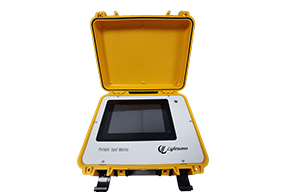
Overview
In oil or gas extraction processes, optimizing production methods is crucial. It is particularly important to accurately understand the flow rates, volumes, flow patterns, and cumulative trends of solid particles during extraction. The sand monitoring system developed by Lightwaves measures the flow rates, instantaneous flow,and cumulative flow of solid particles during crude oil extraction, natural gas extraction, gas storage injection and production, drilling, logging, fracturing, well completion, workover, andcementing processes.
The sand and gravel monitoring instrument consists of two parts: a compact and robust clamp-on acoustic sensor and a sand and gravel transmitter. It can be applied in any oil&gas field where efficient extraction is needed, allowing for real-time,accurate, and quantitative measurements of sand and gravel flow.
In recent years, there has been a market demand for real-time measurement of particle capacity and flow rates. The unique sensor is installed at appropriate pipeline connections or bends, where the turbulent profile is most representative of fluid characteristics. The sensor directly integrates measurements of solid particle content and flow, eliminating the need for additional flow rate measurements.
Features:
Optimizes Production Efficiency
Suitable for Multiphase Fluids
Qualitative and Quantitative Measurement
Pipeline & Valve Hazard Assessment
Non-Contact, Easy to Install, Easy to Calibrate
Facilitates Most Efficient Control Methods Wells
In oil or gas extraction wells, solid particles/sand gradually increase with the extraction process. As the well ages, solid particles/sand adhering to the inner walls of the well or pipeline will accumulate year by year, potentially leading to blockages. It is essential not only to prevent the increase of solid particles/sand but also to optimize the production process, which presents a significant technical challenge. If not managed properly, these particles/sand can cause damage to pipelines or valves.
Therefore, it is crucial to monitor the flow rate, instantaneous flow, cumulative flow, and movement patterns of sand in the pipeline in real time. When solid particles or sand continuously accumulate during production, it is necessary to assess the risks associated with these particles. Hence, real-time monitoring of the operational status of solid particles/sand in the pipeline is essential.
When sand enters the wells or pipelines during the extraction process, it is essentialto ensure the clear passage of the sand. Real-time monitoring of the flow rate, instantaneous flow, cumulative flow, erosion rate, and movement patterns of sand/solid particles is crucial.
The foundation for measuring solid particles/sand monitoring requires real-time detecting and predicting of the flow rate, instantaneous flow, cumulative flow,erosion rate, and movement patterns of sand.
Using the sonar principle based on passive acoustic sensing, the movement patterns of sand and solid particles can be measured, allowing for the determination of flow rate,instantaneous flow, and cumulative flow of sand in natural gas, crude oil,drilling fluid, and fracturing fluid. When sensors are installed at pipeline bends, they monitor the acoustic signals generated by solid particles colliding with the inner walls of the pipeline, and analyze the flow of sand in real time.
Acoustic Sensor
The unique acoustic sensor is an intrinsically safe unit(ATEX EEx ia IIC T4), made from 316 stainless steel, with a protection rating of up to IP68. The acoustic sensor can be widely used in various on-site conditions. Installation is very simple; the sensor can be bundled to the outer wall of the pipe with a stainless steel strap, or connected to the elbow using a stainless steel adapter. his allows it to receive acoustic waves generated by solid particles colliding with the pipe wall. Since the sensor only receives signals from a very narrow bandwidth, it effectively filters out noises generated by gases or liquids.Changes in the frequency and amplitude of the acoustic signals can reveal the flow rate, instantaneous flow, cumulative flow, and movement patterns of sand in the pipe.
Integrated Measurement of Flow Rate, Flow, and Flow Patterns
The sand monitoring system from Lightwaves integrates the measurement of fluid patterns, flow rate, instantaneous flow, and cumulative flow of sand. It is a low-cost,real-time monitoring system for predicting the flow patterns and cumulative trends of sand. All data is transmitted through the compact main unit of the sand monitoring system (which includes a Zener barrier and RS485(Modbus) data and communication module), allowing for data transmission over distances of up to 1500 meters. It can connect to the customer’s data acquisition systems, such as DCS, PLC, and SCADA systems, to monitor the flow rate, instantaneous flow, and cumulative flow of sand in crude oil&gas pipes. The data can also be stored in the main control unit or imported and downloaded to a PC for analysis via cable connections.


Copyright © Lightwaves Website Map